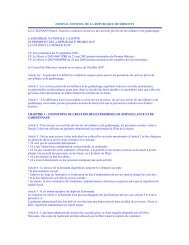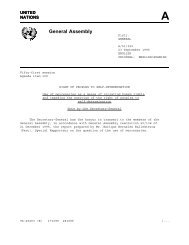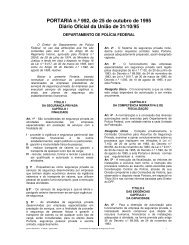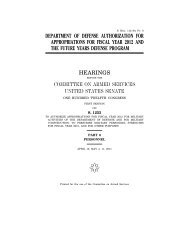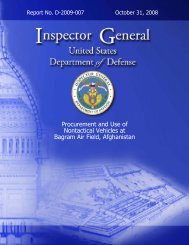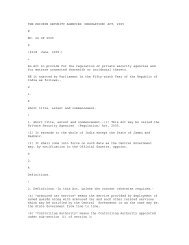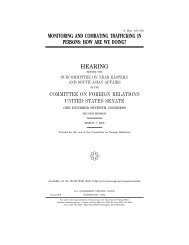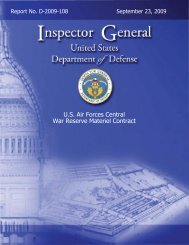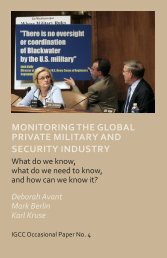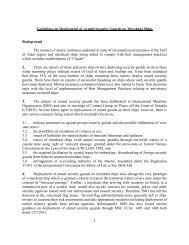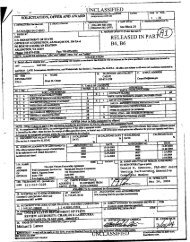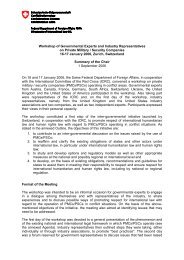A Framework for Regulation - Private Security Monitor
A Framework for Regulation - Private Security Monitor
A Framework for Regulation - Private Security Monitor
- No tags were found...
You also want an ePaper? Increase the reach of your titles
YUMPU automatically turns print PDFs into web optimized ePapers that Google loves.
James Cockayne and Emily Speers Mears 15would also coordinate the mixed commission andhandle any specific complaints relating to memberconduct.The administrator would coordinate the semiannualmembers’ assembly and manage the club’sfinances and general administration.FinanceThe club would be financed by membership fees,according to a graduated scale to ensure that participationcosts were not prohibitive <strong>for</strong> any GSIstakeholders. It would cost around $1 million perannum ($500,000 personnel costs; $300,000operating costs; $200,000 overhead). This wouldenable it to carry out significant research, handlereporting, manage the mixed commission andsemiannual members’ assembly meetings, andcover the cost of staffing and running thesecretariat. A separate voluntary trust fund wouldcover participation <strong>for</strong> smaller members in themembers’ assembly.What are the Barriers?There are no legal barriers to the establishment of aGSI club. It is a soft tool <strong>for</strong> standards implementationonly, one that would have no en<strong>for</strong>cementpower other than peer pressure. As a result, it couldeasily become a means <strong>for</strong> stakeholders to arguethat they were involved in a process of improvingstandards implementation and en<strong>for</strong>cement, whileeffectively doing neither. Existing clubs, such as theVoluntary Principles on <strong>Security</strong> and HumanRights, already suffer similar criticisms. 26 Given thevery diverse nature of the likely membership of aGSI, a club would also be vulnerable to a weakeningof the common “ethic” and system of peer pressurethat provides a club’s only real power to en<strong>for</strong>ceparticular standards. 27What are the Benefits?Its participatory nature would be the key addedvalue of a multistakeholder GSI club. And the clubcould also provide a <strong>for</strong>um <strong>for</strong> coordinating anddeveloping the various functions discussed inprevious blueprints, including in<strong>for</strong>mation collection,dispute resolution, and accreditation, as partof an interlocking umbrella framework.What Next? Three StepsToward Realizing a Global<strong>Framework</strong>A global framework to assist states in regulating theglobal security industry could be put in placequickly, based on the standards that already exist.The blueprints above are intended as discussionstarters<strong>for</strong> how this might come about. All threemain stakeholder groups—states, industry, and civilsociety—have an interest in considering whether itmay be possible to develop a comprehensive GSIframework. As one PMSC noted in its commentson a draft of Beyond Market Forces:responsible industry players welcome … improvedregulation of the industry, more closely definedlegal status <strong>for</strong> companies and staff working in thefield, and effective mechanisms <strong>for</strong> company andindividual accountability… Aside from the clearethical imperative … we are also mindful of thebusiness benefits of differentiation and improvedperception of the sector. 28IPI recommends that stakeholders in the GSI takethree steps to develop a comprehensive globalframework based on the blueprints detailed above:(1) consult within stakeholder groups onframework options; (2) agree upon the negotiationprocess; (3) negotiate. These steps are based on areading of what is politically feasible, as well asnormative guidance drawn from the InternationalOrganization <strong>for</strong> Standardization, the WTOTechnical Barriers to Trade Agreement, and othersources on how such standards frameworksimpacting global business ought be developed. 29States should work with their civil society andindustry partners to convene a series of consultations<strong>for</strong> each stakeholder group, and specific clientsegments, to consider what kind of frameworksmight be feasible. These consultations should eachproduce a simple statement of what the respectivestakeholder group considers feasible, and what“scope” any framework should have—ie., what itshould actually seek to regulate. These statementswill help to clarify whether subsequent ef<strong>for</strong>tsshould be channeled toward one shared framework,26 See Part IV of Cockayne, Mears, et al., Beyond Market Forces.27 As is evident in the case of the VPSHR.28 Comments of Control Risks Group, September 30, 2008, available at www.ipinst.org/gsi.29 For a detailed breakdown of what each step would entail, see Part V, Beyond Market Forces.



